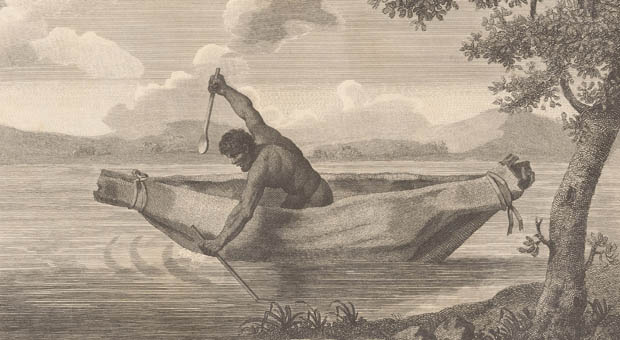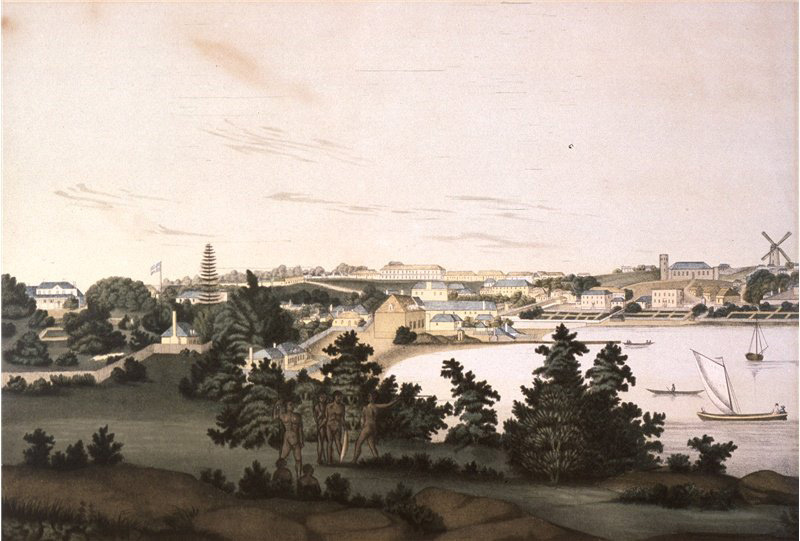‘The Sydney Wars 1788-1817: mythbusting around the Harbour and the Hawkesbury’, Honest History, 19 June 2018
Lyndall Ryan reviews The Sydney Wars: Conflict in the Early Colony, 1788-1817 by Stephen Gapps
It seems extraordinary that, after 230 years, the myths of benign colonisation and absence of Aboriginal resistance during the first decades of British settlement at Sydney are still firmly entrenched in the Australian narrative. Among recent histories of the Sydney region, Grace Karskens’ The Colony suggests a relatively benign period of race relations in comparison with later frontier wars, Keith Vincent Smith’s biography of Bungaree contends that the Aboriginal people of Sydney came to an accommodation with the invaders, and Peter Turbet’s Australia’s First Frontier argues that it was the nature of Aboriginal resistance at the Hawkesbury in the 1790s that made it – rather than the immediate Sydney area – the original site of the frontier war.
 In this book, Stephen Gapps engages with each claim to forge a more sober account of the period. He builds on the work of military historian John Connor, who pioneered the field in 2002, and undertakes a deeper reading of the military sources to argue that the Sydney region was only secured in 1816 after a long and bitter campaign against the resistance of the Aboriginal owners.
In this book, Stephen Gapps engages with each claim to forge a more sober account of the period. He builds on the work of military historian John Connor, who pioneered the field in 2002, and undertakes a deeper reading of the military sources to argue that the Sydney region was only secured in 1816 after a long and bitter campaign against the resistance of the Aboriginal owners.
It is not clear whether Gapps is a military historian, but he certainly reads the sources from a military perspective. He queries the concept of benign intent by arguing that the Sydney region was a semi-militarised environment from the outset. He takes the view that, having claimed the eastern part of Australia in 1770, the British were well prepared to defend the territory against other European claimants and to wrest the Sydney region from the Indigenous owners.
To make his case, Gapps relies on a close study of the writings of the key military officers who served in the Sydney region. These include the account by Watkin Tench, a leading officer in the Marines which defended Sydney from 1788 to 1792, the correspondence of William Paterson, colonel in the New South Wales Corps, the colony’s military garrison from 1792 to 1809, and the papers of Lachlan Macquarie, governor from 1810 to 1821, whose regiment helped to secure the Sydney region from 1810 to 1817. In the process, Gapps deftly disposes of long held misunderstandings about the tactics used by the military forces.
First is the widespread belief that the forces were only trained in the tactics of formal battle and, when confronted with the guerrilla tactics of Aboriginal resistance, they ‘blundered about in the bush’, allowing the enemy to melt away. On the contrary, Gapps contends that the Marines from the First Fleet were well experienced in bush tactics from their deployment in the war against the rebels in North America where they spent more time tracking down fleeing rebels in the woods than engaging them in formal battles.
Gapps also claims that Tench used his tactical experience as a Marine officer to originate the dawn raid against Aboriginal camps in reprisal for the killing of British personnel. The tactic was so successful that it was widely deployed across the colonial frontier over the next century. In Gapps’ analysis of the NSW Corps, he shows how the soldiers operated with militia forces in several successful search-and-destroy operations against Aboriginal people in the Sydney region to 1810, and then compares the operations with the equally successful tactics of Macquarie’s 73rd regiment against Aboriginal resistance between 1810 and 1816. Gapps concludes that the military forces in the Sydney region were well trained in the tactics of small scale engagements and punitive raids on Indigenous camps, as the most successful means of securing new territory for the Empire.
Another widespread belief is that, following the smallpox epidemic of 1789, few Aboriginal people remained in the Sydney region. Gapps contends that Aboriginal people always outnumbered the colonists on the Sydney frontier to 1817, that they strode about in groups with amazing confidence, were brazen in plundering food supplies, and frequently attacked convict servants. Many colonial farmers on the Hawkesbury lived in constant fear of attack by Aboriginals to contain whom there were simply never enough soldiers .
 Pemulwuy or Pimbloy (c. 1750-1802), Bidjigal man, Botany Bay area (SydneyBarani/NLA/James Grant)
Pemulwuy or Pimbloy (c. 1750-1802), Bidjigal man, Botany Bay area (SydneyBarani/NLA/James Grant)
Gapps argues that Macquarie began the practice of conferring paramilitary powers on local magistrates – many of whom were retired army officers – so they could swiftly respond to Aboriginal attacks on colonial lives and property. These powers included deploying militia forces of able-bodied colonial men to track down alleged Aboriginal outlaws. As an example, Gapps provides the first sustained account of the paramilitary operations carried out by magistrate William Cox from July to September 1816 to secure the newly built road across the Blue Mountains.
Gapps draws on the evidence of Aboriginal and European descendants in the region to flesh out the details. Cox formed a militia group of five detachments, each of 11 men, a commander, five soldiers, three white guides and two Aboriginal guides. Even though no military officers were involved, ‘the sergeants, corporals and constables in command all had experience in independent manoeuvres’ and all were under Cox’s command. Their orders were to scour the deep ravines on both sides of Cox’s road to Bathurst and ‘strike terror’ into all the Aboriginal people in the region by killing and utterly destroying any ‘hostile natives’ who were deemed ‘outlaws and murderers’.
Cox’s campaign was indeed a reign of terror. Gapps contends that Aboriginal men were shot down at will and their bodies strung up on trees to serve as a message to their comrades – those who were still alive – that they should surrender.
Cox’s campaign can also be described as a textbook search and destroy operation. His tactics would be deployed in the 1820s in the Hunter region and in Tasmania to drive Aboriginal people from their homelands and force their leaders to sue for peace. And, like Cox, other magistrates would have no hesitation in authorising the tactic of massacre to secure the frontier. Although Gapps appears to argue that the ‘British adapted their military tactics to use Aboriginal people and local European guides, to attack camps at dawn and to comb the countryside with mobile military forces’ (p. 258), the use of police magistrates to conduct operations against insurgents is another important factor and deserves further exploration.
Gapps also finds that, as in my own research on the Tasmanian frontier in the 1820s, the alleged Aboriginal killing of white women was the catalyst for the most drastic reprisals. According to Gapps, the Appin massacre of 1816 was the result of this belief. But he overlooks the first part of the process that leads to massacre, the killing of Aboriginal women by white men.
This is a small oversight, however. In returning New South Wales to its British imperial origins and presenting the colony’s early decades as a semi-militarised society, Gapps demolishes the myths of benign colonisation, Aboriginal accommodation and military incompetence, and foregrounds the critical role of the magistrates in securing the frontier. He also shows that para-military practices were in place on the Sydney frontier long before the massive pastoral expansion of the 1820s and 1830s, that the war of 1816 became embedded in local Aboriginal and settler memory, and that across the entire period there were an estimated 300 casualties overall from 250 recorded incidents. The statistics are certainly comparable with Brian Plomley’s compilation of incidents in the frontier war in Tasmania from 1819 to 1830. They also advance Gapps’ claim that the entire Sydney region, rather than just the Hawkesbury as Peter Turbet contends, should be reframed as Australia’s first frontier. Finally, Gapps shows that, as in the Tasmanian frontier war, the convicts were the cannon fodder of the frontier wars in the Sydney region and their sacrifice tends to be overlooked.
 Sydney c. 1810 (Wikipedia/John Eyre)
Sydney c. 1810 (Wikipedia/John Eyre)
The Sydney Wars is a critically important book. In forcing the reader to consider Sydney’s first decades afresh, Gapps has overturned the long held myths of the British colonial project. Conquest was always the key purpose of the British occupation of Sydney and the military garrison and the settlers knew that it would not be achieved without forcing the Indigenous owners to surrender their homelands. Gapps must be congratulated for stripping away the romanticism of Sydney’s early decades and repositioning them through his more realistic assessment of the violence of colonial conquest.
* Lyndall Ryan is Research Academic, Centre for the History of Violence, School of Humanities and Social Science, University of Newcastle, Australia. Her most recent book is Lyndall Ryan & Jane Lydon, ed., Remembering the Myall Creek Massacre (NewSouth 2018).


Leave a Reply
You must be logged in to post a comment.